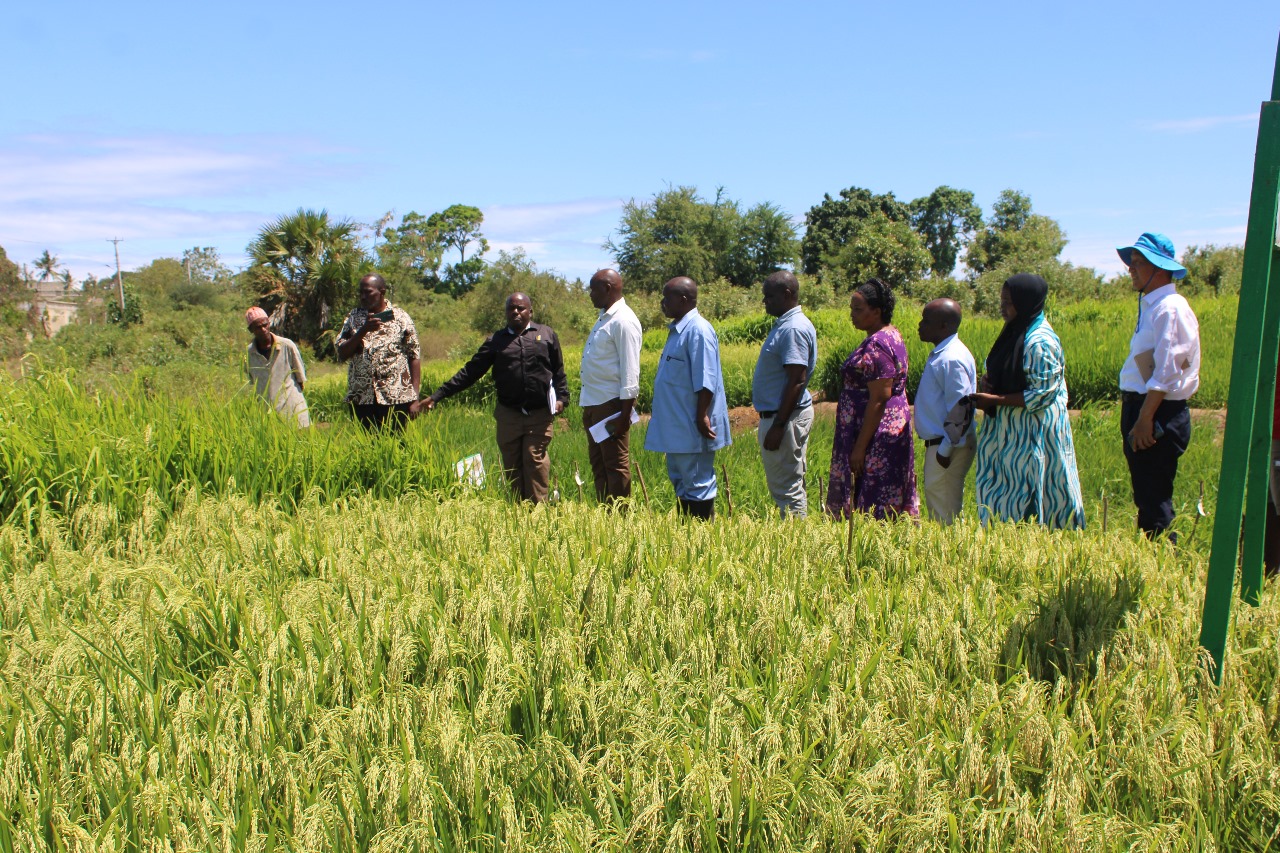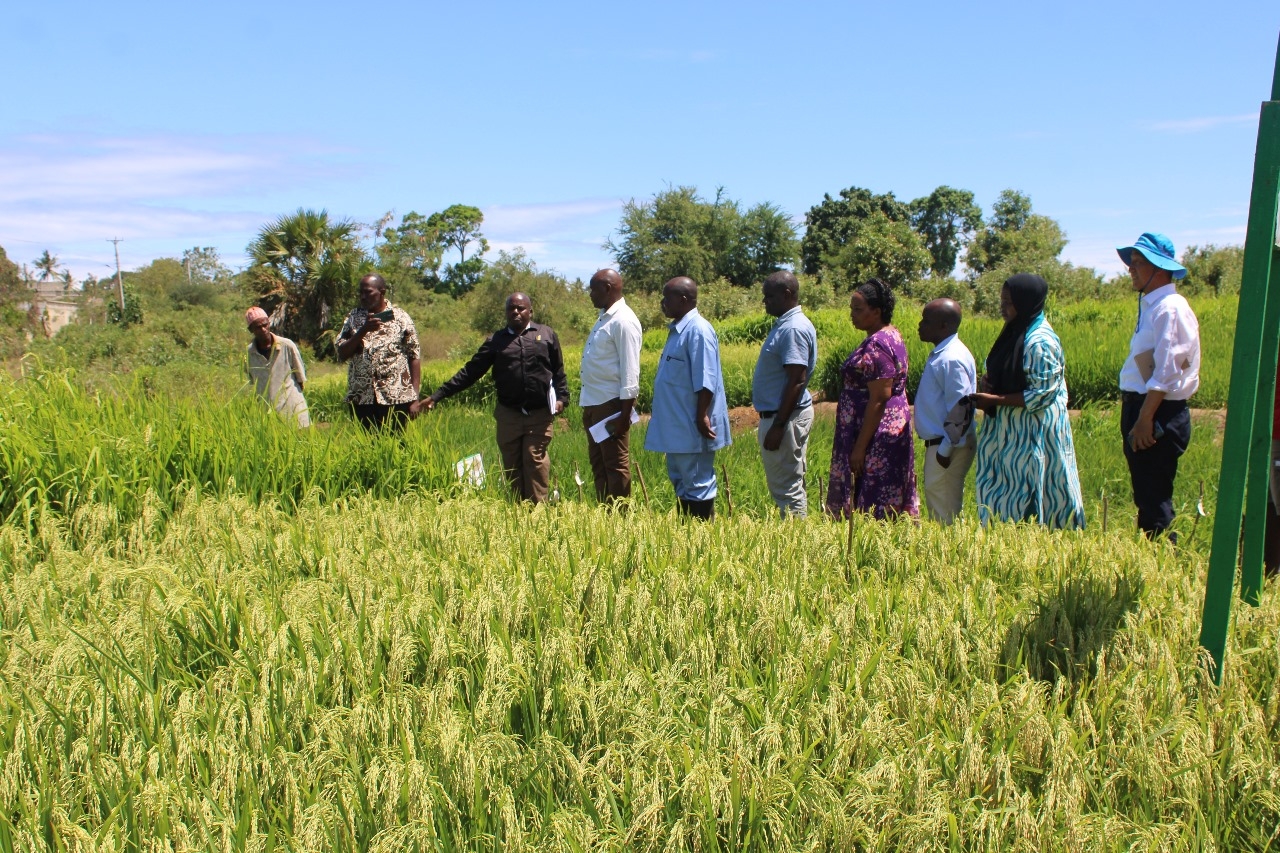

Coast rice farmers, Kalro officers and Kopia Kenya
Centre’s Ji Gang Kim at Kalro Mtwapa on Tuesday /BRIAN OTIENO
Rice farmers at the Coast have received a boost with new skills and rice variety that will help them produce more.
The farmers have
been getting poor yield because of outdated methods of farming, yet
the region has the potential to be the breadbasket of the country in rice
production.
Speaking after a
two-day training session for farmers from Kilifi, Kwale and Taita
Taveta counties at the Kenya Agriculture and Livestock Research Organisation (Kalro)
in Mtwapa, stakeholders said the region has perfect conditions for the Kwamboka
variety of rice that is fast maturing and more resistant to extreme conditions.
“Right now we have a new variety of rice called Kwamboka developed by Kalro, which we have seen in the model farms can do well at the Coast,” Mwagona said.
He said the county
will now invest more in rice farming to harness the region’s potential.
Korea Partnership for Innovation of Agriculture (Kopia)
Kenya Centre director Ji Gang Kim said consumption of rice is increasing in
Kenya but production is still low.
“Rice productivity varies greatly from region to
region. In the coastal area, the productivity is very low,” Ji said.
Kopia is the financier of the new variety of rice
and the model farms in the Coast region.
Ji said with the new technologies and varieties
introduced at the Coast, he is optimistic production will steadily increase to
match consumption.
“Without increasing productivity in the coastal area,
it is not easy to increase consumption. That is why we started carrying out
this rice project to improve the rice cultivation technology in the coastal
area,” he said.
Ji said there is a low adoption of technology in
rice farming at the Coast, compared to traditional rice growing areas of Mwea
and Ahero.
Kalro Industrial Crops Research Institute director
Simon Omondi said the Coast region has a chunk of land bigger than Mwea and Ahero
that can be used for rice farming.
He urged different stakeholders, including
county governments and private investors, to collaborate to invest in rice
farming at the Coast.
On average, an acre of rice farm at the Coast
produces about 35 bags, after having spent an average of Sh70,000 in production
costs.
“From an acre, one can get Sh160,000 worth of
rice. This means rice farming at the Coast can be a big thing if embraced,”
Omondi said.
Kalro has started training lead farmers and extension
staff to spread the rice farming news in the region.
John Kimani, a Kalro rice researcher, said the Kwamboka
variety can withstand effects of climate change.
Kimani said the Coast region has the potential to
produce rice that can feed the whole nation, and remain with surplus that can
be exported.
Bebaya Boy, a Kwale
rice farmer, said he was uninformed on many aspects of rice farming before the
training.
He said he never
used to estimate how much produce his one-acre farm should produce and would
just harvest any amount that comes his way.
“Whenever we
harvest we put in the granary, without keeping records. So right now, I cannot
tell you how many bags we produce on average.
“We didn’t know
that an acre of rice should ideally produce about 54 bags of rice. We have been
harvesting any amount of bags ranging from eight to 20 bags depending on our
blessings,” Boy said.
He said the
training has really opened his eyes.
“I never knew about
spacing. I just planted rice. Now I know what spacing is required and what
amount of water, fertiliser and type of soil is needed for best productivity,” Boy
said.
He said with the
new knowledge, there is likely to be a surge in rice farming in Kwale
because rice fetches more money than maize.
“A kilo of rice
fetches Sh120 while a kilo of maize fetches around Sh25,” Boy said, adding he will now increase the acreage under rice.
Jane Kanam, the
Kaloleni subcounty agricultural extension officer in Kilifi, said rice
farming skills in Kaloleni has been low, even among agricultural extension
officers.
“We had left rice
farmers on their own because most of us had no knowledge on rice farming,” she said.
Kanam said rice
framing in Kaloleni has been characterised by broadcasting method if planting
which is inefficient, lack of fertiliser and in most cases late planting.
“This means
productivity has been very low. We have been told an acre under rice should ideally
produce 54 bags but in Kaloleni subcounty, farmers have been getting four to five bags
per acre,” she said.
Kanam said with the
new skills and knowledge, they will spread the gospel and help farmers
increase their produce.
She said they
will group farmers in batches so they can spread the new knowledge.
“We want to get to
at least 25 bags per acre because most of our farming is rain-fed unlike in
Mwea and Ahero where rice farming is irrigation-based,” Kanam said.
Eunice Chao, a rice
farmer from Taita Taveta county, said she expects improved produce
“The knowledge I
have acquired is not far from what I had, but at least there are things I now
know that I did not know before,” she said.
Chao said she
learned rice farming from neighbours.
She harvests about 35 bags of rice per acre, but believes with the new knowledge she has
acquired, this will improve to at least 50 bags.
“We are also now
going to adopt new technologies in rice farming. We have been using jembes, but
now we will have to upgrade and use power tiller,” Chao said.
Lunga Lunga
subcounty agricultural extension officer James Kadzenya said Kwale is a very fertile
place for rice farming but most farmers have no deep knowledge of the farming.
He said in Lunga
Lunga, farmers produce between eight and 16 bags per acre because farmers do not use
fertilisers or give the right spacing.
“We, as officers,
will start changing the attitudes of the farmers by talking to them and passing
this new knowledge that we have acquired to them,” Kadzeya said.
He said Lunga
Lunga is the major rice farming subcounty in Kwale county, which has more than 1,000
farmers.
“Most of the farms
in Lunga Lunga have the best soils for rice farming. The variety of rice that
is common in Kwale county is Pachanga, which takes about seven months to
mature.
“Now, we have been told about another variety, Kwamboka, that takes about three months to mature and produces uniformly,” Kadzeya said.
Instant Analysis:
The Coast region is not known for rice farming.
However, with the new Kwamboka rice variety, which is resistant to harsh
climatic conditions, the region can be the rice basket of Kenya.

















